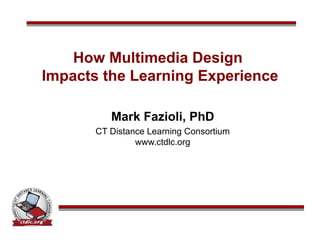
CTDLC Multi-Media Design Presentation
- 1. How Multimedia Design Impacts the Learning Experience Mark Fazioli, PhD CT Distance Learning Consortium www.ctdlc.org
- 5. Cognitive Model of Multimedia Learning Online Multimedia Instruction Sensory Memory Working Memory Long-Term Memory Words Pictures Ears Eyes Sounds Images Verbal Model Pictorial Model Prior Knowledge Selecting Words Selecting Images Organizing Words Organizing Images Integrating (Mayer, 2001)
- 7. Graphics and Images for Learning
- 19. Cognitive Model of Multimedia Learning Online Multimedia Instruction Sensory Memory Working Memory Long-Term Memory Words Pictures Ears Eyes Sounds Images Verbal Model Pictorial Model Prior Knowledge Selecting Words Selecting Images Organizing Words Organizing Images Integrating (Mayer, 2001
- 21. Cognitive Model of Multimedia Learning Online Multimedia Instruction Sensory Memory Working Memory Long-Term Memory Words Pictures Ears Eyes Sounds Images Verbal Model Pictorial Model Prior Knowledge Selecting Words Selecting Images Organizing Words Organizing Images Integrating (Mayer, 2001
- 22. Cognitive Model of Multimedia Learning Online Multimedia Instruction Sensory Memory Working Memory Long-Term Memory Words Pictures Ears Eyes Sounds Images Verbal Model Pictorial Model Prior Knowledge Selecting Words Selecting Images Organizing Words Organizing Images Integrating (Mayer, 2001
Notes de l'éditeur
- When words and pictures are both presented, students have an opportunity to construct verbal and pictorial mental models and build connections between them. When words are presented alone, students have an opportunity to build a verbal mental model but are less likely to build to build a pictorial mental model and make connections between the verbal and pictorial mental model.
- Instructional graphics are classified into taxonomies or categories of functions that allow for the creation of a visual relationship in the user’s mind To help build associations to foster retention.
- These visual images are used in instructional materials or presentations strictly for comical, aesthetic or motivational purposes. Sometimes referred to as eye candy, decorative graphics are used to spice up the screen or page. It is best to limit the number of these graphics used throughout the online course material, since it can interfere with the instructional goals and lessen retention of the material.
- These graphics depict the instruction in a concrete fashion. They communicate information quickly and easily. If words are used in a representative visual they represent exactly what they are try to convey both in the visual as well as the accompanying text. Examples of this type of graphics include symbols, icons, screen captures, and photographs relating to the real object or content (text).
- These graphics are used primarily to assist the learner to associate relationships between sequences of steps to incorporate information. Examples are visuals such as employee organization charts, course maps and table of contents fall into this category.
- These graphics help learners understand difficult content through cause and effect relationships.
- Relational graphics are primarily used to express relationships among components within charts and diagrams. These would include pie, line and bar charts.
- Transformational – visuals that illustrate changes in time or over space (animated).
- Some historians of visual works refer to this style of lettering as “Fonts without wings.” This is evident because the word sans means without so Sans Serif means “without Serifs.” There are none of the little extensions or feet at the end of the characters as in Roman/Serif type.
- Some of the most common styles are Verdana, Arial, Trebuchet, Helvetica and Futura. For online instructional materials Sans Serif fonts are the most desirable. This is due to the fact that computer screens rely on resolutions to display items, so in the case of Roman/Serif type the screens do not display the Serifs making the lettering hard to read. Studies have found that sans serif fonts tend to make people less tired when reading material off computer screens in essence increasing the potential for learner retention.
- When corresponding words and pictures are near each other on the page or screen, learners do not have to use cognitive resources to visually search the page or screen and learners do not have to use cognitive resources to visually search the page or screen and learners are more likely to be able to hold them both in working memory at the same time.
